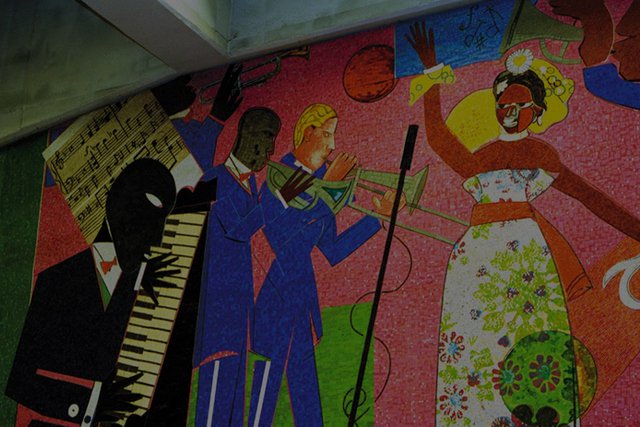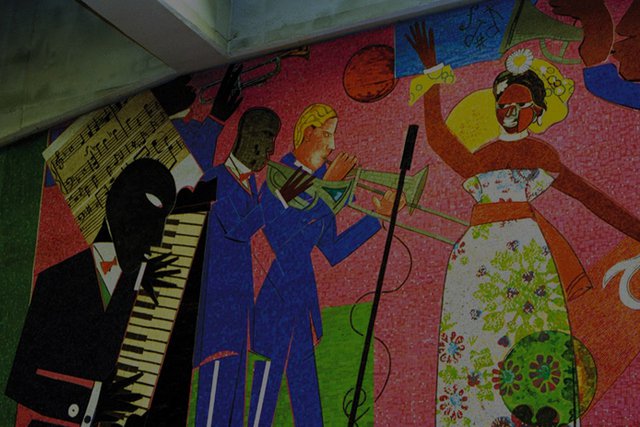[ad_1]
By Sean Yoes, Baltimore AFRO Editor, [email protected]
The vast majority of people who pass through the Upton Metro station, the second busiest Metro stop (Penn-North is first) in the city, probably don’t realize that an American art masterpiece hangs in their midst, looming over all that enter.
“A Baltimore Uproar,” is perhaps the most famous mosaic of Romare Bearden, one of the most important American artists of the 20th century.
Bearden’s masterpiece, the 14’x 46’, multicolored venetian glass mosaic depicts a jazz band featuring Baltimore’s Billie Holiday, perhaps the greatest jazz singer of them all on the mic, accompanied by six jazz musicians.

A Baltimore Uproar has hung in the Upton station since 1982; it is undeniably beautiful, but far too few Baltimoreans know about Bearden’s art and his connection to the city.
However, there are individuals and organizations that have been quietly working to introduce Bearden to a new generation of Baltimoreans.
On April 19, a free workshop will introduce the work of Romare Bearden to the parents of students at the Henderson-Hopkins School, at 2100 Ashland Ave., in East Baltimore. The workshop will be conducted by Diedre Kelly of the Romare Bearden Foundation in Harlem. Kelly, who is Bearden’s niece, is co-director of the Bearden Foundation, which is one of the sponsors of the event, along with the Baltimore chapter of Pierians (an art appreciation organization), Starbucks and the Henderson-Hopkins School.
The art of Romare Bearden was initially introduced into the Baltimore City Public Schools (BCPS) curriculum in Nov. 2014 at Henderson-Hopkins. In March 2017, BCPS implemented system-wide workshops for all public school certified art teachers, which was 51 teachers at the time, at 51 schools.
“Bearden is the foremost American collagist of the 20th century…the only Black artist honored with a one-man retrospective at the National Gallery of Art,” said Lewis Hudnell, a retired professor of Criminal Justice at American University and art impresario, who was integral in getting the Bearden art curriculum into BCPS and generally educating people about Bearden’s work. He is behind a series of events that will be revealed later this year celebrating the life and legacy of this transcendent American artist, who began his professional career in Baltimore as an editorial cartoonist for the AFRO American Newspapers.
In 1935, Bearden was hired by Dr. Carl Murphy, the legendary AFRO publisher. From 1935-1937, Bearden’s cartoons captured the pulse of Black America, as the world moved to the brink of World War II and the Black community in Baltimore and around the country prepared to wage the decades-long fight to dismantle Jim Crow.
During that time specifically, the AFRO led by “Mr. Carl” as he was known, forged a partnership with the resurgent Baltimore branch of the NAACP. The mission was to integrate the University of Maryland Law School at Baltimore. In 1935, a young lawyer named Thurgood Marshall orchestrated the legal strategy (guided by his mentor Charles Hamilton Houston, perhaps the greatest legal mind of the 20th century), that led to the first school desegregation victory in America.
The integration of the University of Maryland Law School by Donald Gaines Murray, led to a series of desegregation victories around the state and began the arduous 20 year road to Brown v. Board of Education, in 1954.
The year of the Murray victory, 1935, was the year Murphy hired Bearden as the AFRO’s cartoonist.
For two years, Bearden’s dark and incendiary cartoons reflected the harrowing days of the Great Depression, international conflict and chaos and the battle to tear down government sanctioned White supremacy and racist terrorism against Black Americans.
Before he moved on to international acclaim, which included him being awarded the National Medal of Arts by President Ronald Reagan, Bearden’s art fueled the editorial page of the AFRO at one of the most important and pivotal times in this newspaper’s history.
Sean Yoes is the Baltimore editor of the AFRO and the host and executive producer of the AFRO First Edition video podcast, which airs Monday and Friday on the AFRO’s Facebook page.
[ad_2]
Source link


